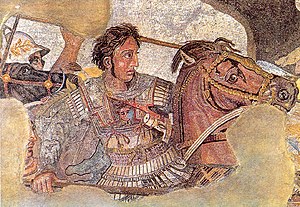
Our history readings brought us to the times of Alexander the Great. Story of the World vol 1 (SOTW) describes briefly some important facts about this great man. It was a little of an anti-climax because my boys, having read on their own a few books about Alexander, knows more about him than was covered in SOTW! As such, their narrations were "adulterated" with information from those other books. However, I welcomed those "extra" information.
I am reminded and assured that my children's learning don't always depend on my teaching them. They are perfectly capable of discovering and learning themselves. Don't we parents worry too much about that sometimes!!
As we were searching for images to accompany their narration, we came across an interesting etext of James Balwin's Thirty More Famous Stories Retold. Baldwin is no stranger to me as I already have his other book Fifty Famous Stories Retold. I was thus pleasantly surprise to find this. Baldwin's version of the Gordian Knot was different somewhat from what we read in SOTW.
Below is my boys' narration of the Gordian Knot as told in SOTW. Read the two versions yourself and see the difference.
When his father died, Alexander took over his throne. He went across the Aegean Sea toward the
Alexander used his sword to cut the knot into half and loosened it. Nobody thought of this method before.
Alexander eventually became king of the Persian Empire. He marched his army down to Egypt and was crowned Pharaoh. He also conquered Mesopotamia.
Alexander’s empire was the biggest empire that the world had ever seen. He was known as Alexander the Great!"
It brings to light some important points. History is NOT an exact Science. History is written by people. Different people see and interpret events differently. People may also embellish their writings with interesting details that may not be accurate.
This gives me a chance to point out to my boys that as a reader, we must not always believe what we read (or hear or see...). We should always refer to different sources, so that we can see the bigger picture, and also be in a better position to evaluate a piece of information.
Visit Rumphius History Webpage to find out more about how we approach History in our homeschool.









No comments:
Post a Comment